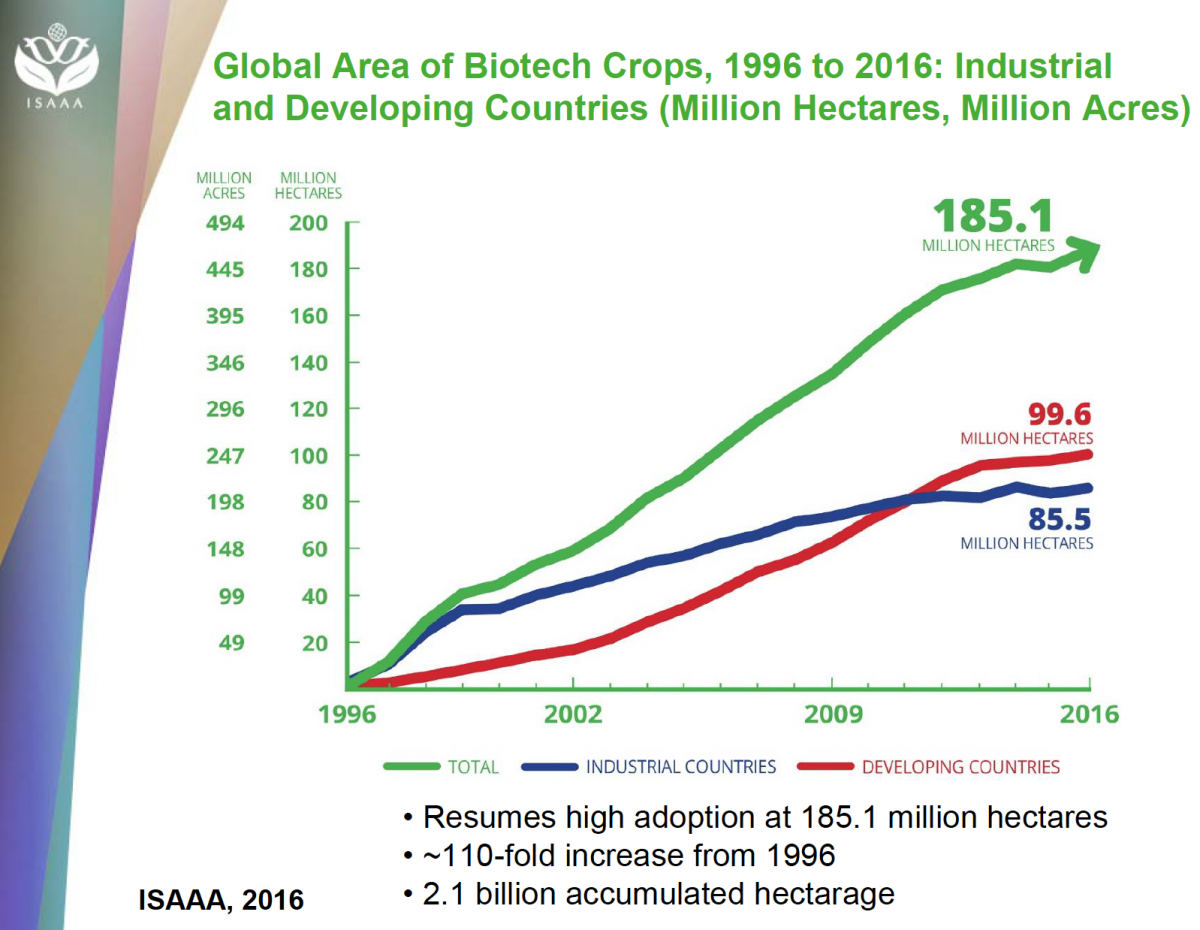
The cultivation of genetically engineered (GE) crops has hit a new global peak, resulting in significant economic and environmental benefits, according to a report from the International Service for the Acquisition of Agri biotech Applications (ISAAA).
Farmers in 26 countries planted 185.1 million hectares (457.4 million acres) in GE crops last year. This represents a 6-million-hectare increase from the previous year and a turnaround from 2014-2015, when global biotech crop area fell slightly. Nearly 90 percent of the crops were grown by small-holder farmers.
Some 56 percent of the GE crops are being grown in 19 developing nations, where biotechnology has helped alleviate hunger by increasing the incomes for 18 million small-holder farm families, improving the finances of more than 65 million people, the report states.
Biotech crops also have achieved significant environmental benefits, according to the report. These include cutting herbicide and insecticide use by 19 percent; reducing CO2 emissions largely due to reduced tillage equal to annually removing approximately 12 million cars from the road; and conserving biodiversity by sparing 19.4 million hectares of land from agriculture in 2015.
While the ISAAA report heralded the production increases and benefits, it also cautioned that GE crops are not a panacea. Agriculture must use the best of both conventional and biotech crop technology to achieve a safe, sustainable intensification of crop productivity on the 1.5 billion hectares of farmland under cultivation globally, the report stated.
Important commodities like maize (corn), cotton, canola and soy still comprise the bulk of GE crops being grown. Sugar beet and alfalfa are also major GE crops. Hawaii produces a virus-resistant papaya, and Bangladesh is now growing the pest-resistant Bt brinjal (eggplant.) ISAAA officials expect the adoption of biotech crops to continue expanding as new varieties come on the market and additional countries permit cultivation.
With the commercial approvals and plantings of new varieties of biotech potatoes and apples, consumers will begin to enjoy direct benefits of biotechnology with produce that is not likely to spoil or be damaged, which in turn has the potential to substantially reduce food waste and consumer grocery costs, said Paul S. Teng, chairman of the ISAAA Board, in a news release.
Africa, in particular, is poised for expansion. Cultivation of biotech maize, soybean and cotton increased in South Africa and Sudan last year, while a new wave of acceptance is emerging as Kenya, Malawi, Nigeria, Ethiopia, Ghana, Nigeria, Swaziland and Uganda make advances in regulatory review and commercial approvals for a variety of biotech crops, the report states.

Even with a long history of regulatory barriers, African farmers continue to adopt biotech crops because of the value they are realizing from the stability and productivity of biotech varieties, said ISAAA Global Coordinator Randy Hautea. As more countries move forward with regulatory reviews for crops such as bananas, cowpeas and sorghum, we believe biotech crop plantings will continue to grow in Africa and elsewhere.
Brazil remains a biotech powerhouse, ranking as the second largest producer behind the United States. Its cultivation of biotech maize, soybean, cotton and canola increased by 11 percent last year, and it now grows more than a third of the GE soybeans produced worldwide.
The US, Brazil, Argentina, Canada and India accounted for 91 percent of the global biotech crop area last year. The European nations of Spain, Portugal, Czech Republic and Slovakia increased their cultivation of biotech maize by 17 percent between 2015 and 2016. Globally, herbicide resistance remains the most popular biotech trait, followed by insect resistance and drought tolerance.
The ISAAA report also was buoyed by new biotech crop advances last year in the West, where the US Food and Drug Administration (FDA) approved the commercial cultivation and sale of the Innate Russet Burbank Gen 2 potatoes and Health Canada approved the fresh market sale of the Simplot Gen 1 White Russet potatoes. Both potato varieties have lower levels of asparagine, which reduces the creation of potentially toxic acrylamide during high heat cooking.
Meanwhile, non-browning Arctic Apples were harvested in 2016 and are now being sold in the US as packaged slices. The US also has approved a fast-growing biotech salmon for human consumption, but sales are temporarily on hold while regulatory agencies develop labeling requirements. A blight-resistant American chestnut and citrus resistant to the devastating greening bacteria are currently in the US development pipeline.
